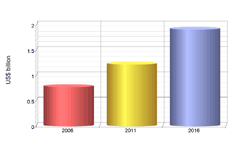Microwaveable Packaging | Robust Growth Predicted
- Published: October 17, 2012, By Ken Sullivan
The $1.2 billion market for primary packaging materials for microwaveable products is forecast to grow at a robust 9.4% annual rate through 2016 according to “U.S. Microwaveable Packaging 2012-2016,” a newly released market research and intelligence report from Allied Development Corp., Burnsville, MN. The study forecasts that U.S. annual sales of primary packaging materials for microwaveable products will nearly reach $2.0 billion in 2016.
 Time savings and convenience have been the principal benefits driving consumer demand for microwaveable food products to date, and they will continue to be so in the future. The U.S. market for microwaveable packaging materials will continue to grow at its current rate, with some added impetus generated by the food processors’ ability to improve the taste and texture of microwaved products, and to introduce new products that meet the health and fitness concerns of consumers.
Time savings and convenience have been the principal benefits driving consumer demand for microwaveable food products to date, and they will continue to be so in the future. The U.S. market for microwaveable packaging materials will continue to grow at its current rate, with some added impetus generated by the food processors’ ability to improve the taste and texture of microwaved products, and to introduce new products that meet the health and fitness concerns of consumers.
The study evaluates packaging technologies that are expanding microwaveable packaging into new end-user categories by increasing package functionality. Consumers prefer products that can be directly placed in a microwave oven without any hands-on activity to modify the packaging by such means as poking holes, cutting slits, peeling lidstock, etc. Because microwaveable products generally are packaged in hermetically sealed containers, the steam that is created by microwave energy is trapped within these containers. Now it is generally accepted by food processors that steam contributes to improved product quality since it creates a consistent and even temperature around the product to promote uniform heating.
Food processors have come to terms with the steam issue by incorporating an integral vent, essentially a controlled-release feature for steam, within their packaging structures. The steam created within the package puts pressure on the release point, eventually causing it to fail, which releases steam through the opening. Integral venting is often designed to occur in the seal between tray and lidstock, or between the seals of a flexible package. The self-venting seal can eliminate the need for consumer interaction with the packaging structure.
Self-venting pouches or trays can be transferred directly from the freezer to the microwave oven, eliminating the need for manual venting by consumers. This feature has helped spur growth in the largest end-user segment—Prepared Meals and Entrees (which in 2011 accounted for 63% of all U.S. sales of primary packaging materials for microwaveable products)—as well in the fastest growing end-user segment: Vegetables. The study forecasts 18.5% annual sales growth through 2016 for primary packaging materials associated with microwaveable vegetables.
Another innovation, susceptor technology, is an ongoing and major development in microwaveable packaging that is contributing to the projected high growth rate of particular types of packaging materials, notably paperboard cartons and sleeves for hand-held entrees and pizza slices. Susceptors enable microwave-prepared foods to more closely match the quality, taste, and texture of food prepared in conventional ovens. This technology has been instrumental in the relatively high growth rate of folding cartons as a type of microwaveable packaging, which the study forecasts to be a 13.2% rate of growth per year through 2016.
The study goes on to point out that even while innovative designs are broadening the market for products in microwaveable packaging, future growth will be limited by their relatively high price point compared to traditional food-prep items and by consumers’ concerns about the perceived “over packaging” of microwaveable products.
Ken Sullivan is director of sales and marketing for Allied Development Corp., a consulting and publications firm whose disciplined, quantitative approach to complex technical issues produces important new knowledge and industry benchmarks for packaging professionals. Ken can be reached at This email address is being protected from spambots. You need JavaScript enabled to view it.. For more information on Allied’s study on “U.S. Microwaveable Packaging 2012-2016,” visit: www.allied-dev.com/Studies





